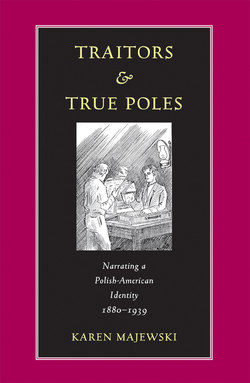Читать книгу Traitors and True Poles - Karen Majewski - Страница 19
На сайте Литреса книга снята с продажи.
Оглавление3
Crime, Punishment, Atonement
A Family Plot
SURELY AMONG THE publications Paryski’s many critics had in mind when they accused him of pandering to his customer’s lowest tastes, and of degrading rather than uplifting the peasant immigrant’s spirit and intellect, were the crime novels to which we now turn. Crime and detective fiction, although not usually considered a major category of ethnic literature, is fairly well represented within Polish-American literary production. Not only were European works reprinted and serialized, but immigrant authors and publishers produced Polish-American contributions to the genre. In addition to their general appeal, these stories contained particular resonances for immigrants that help account for the genre’s popularity and longevity. Even when lacking the trappings of an immigrant social reality, the Polish-American detective narrative replays the basic tensions over group loyalty and betrayal from within that mark so much other Polonian writing. Rather than standing as an aberration in Polonia’s literary history, it restages these conflicts on the most fundamental level of common peoplehood—the family. Within the changing literary forms and styles these works demonstrate, it is possible to trace Polonia’s shifting political and social emphases, as well as changes in the Polish-American publishing business itself.
As early as the 1890s and up to World War I, Polonian newspapers were serializing and Polonian companies were publishing American and European crime and detective stories, including those of Polish author Walery Przyborowski and, in translation, Arthur Conan Doyle. But American Polonia also had its own fictional detective stories. The earliest of these is journalist Henryk Nagiel’s Kara Boża idzie przez oceany (God’s punishment crosses the ocean), first published in 1896. Before turning to the complexities of this novel, however, it may be helpful to look at a series of crime stories that were published some fifteen years later and whose appearance may have prompted the 1912 reissue of Nagiel’s novel. Although much less sophisticated than Nagiel’s work, these works exhibit in crude outline the problems of family succession and continuity that other immigrant crime and detective novels treat as explicitly ethnic issues.
These were truly “pulps,” printed on cheap newsprint in the form of five-by-seven-inch pamphlets of about fifty pages each. The adventures of Bronisław Sęp and of Zofia Jastrzębska, contained in a dozen or so short works written anonymously and appearing between 1911 and 1916, form the Polish-American counterpart to the American dime novels Michael Denning describes as “an essentially anonymous, ‘unauthored’ discourse” in which the commodity is not the author but the hero.1 They include the Sęp adventures Ofiara hypnotyzmu (A victim of hypnotism), Ograbiacze trupów (The corpse robbers),2 Spisek zbrodniarzy (The criminals’ plot), and Widmo w zbroi (The phantom in armor); and, featuring Jastrzębska, Człowiek w żelaznej klatce (The man in the iron cage), Krwawe róże (Bloody roses), Lekarka obłąkanych zbrodniarką (The criminal asylum keeper), Mężobójczyni (The husband killers), Mord w wagonie (Murder on the train), Piekielny zegar (The hellish clock), Tajemniczy mnich (The mysterious monk), Włamywacze (The burglars), and Wróg ludzi (Enemy of the people).
Bibliographical information about these works is difficult to verify and the evidence is contradictory. Not only are authors and sources of origin undocumented, but their publishing history is also difficult to trace. Like many other Polish-American imprints of this period, most of the detective novels indicate a year of publication but do not identify the publisher, which can be deduced only from other evidence, such as the company catalogues that ran in newspapers, almanacs, and in the back pages of other books. Even these sources are not completely reliable, however. Wojciech Chojnacki notes that both Dyniewicz and Paryski catalogues were sometimes misleading as to which items were their own original publications and which imported.3 There is also some evidence that more than one publisher released the same novel. For instance, The Hellish Clock, published by Chicago’s Polish American Publishing Company (without a date), is also listed in Paryski company catalogues beginning in 1911. Paryski also lists Murder on the Train, though it also appears to have been published by Dyniewicz. Similar cases exist among other types of publications as well, particularly involving the Dyniewicz and Paryski firms. The competitive motive is obvious, but it is curious that both Paryski and Dyniewicz seem to have first published this novel in the same year. A publisher might be expected to pirate another’s proven seller, but since this does not seem to have been the case it is more likely that this novel was reprinted from a European import that came into possession of both companies around the same time. No proof of this origin has surfaced, however.
Cover of A Victim of Hypnotism (1911), featuring the Polish-American detective Bronisław Sęp.
